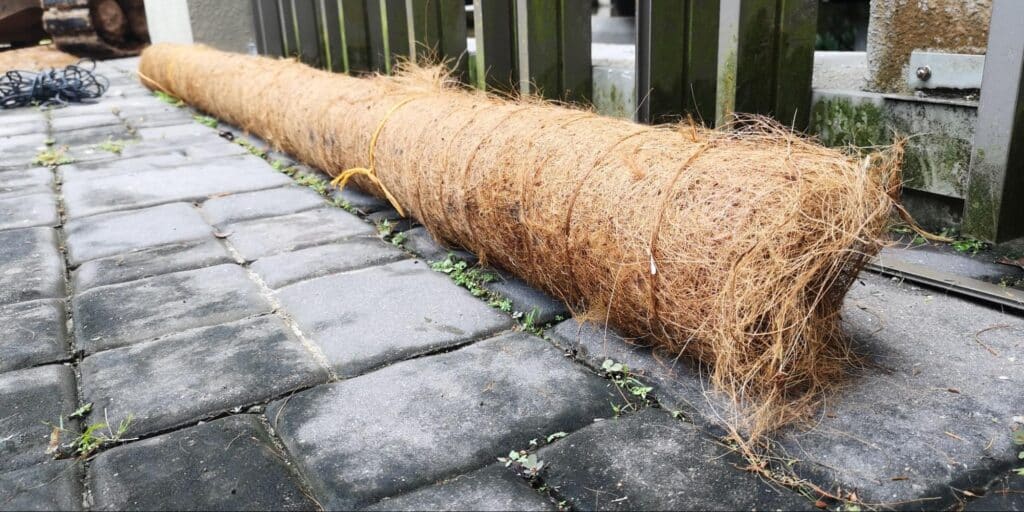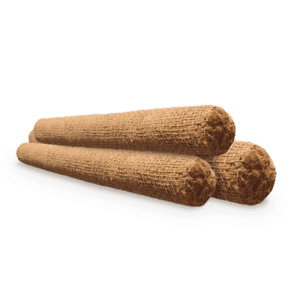Installation Of Coir Logs: The Ultimate Guide to a Beautiful and Sustainable Landscape

Imagine a landscape where beauty harmonises with sustainability—a place where lush greenery thrives, soil erosion is at bay, and wildlife finds refuge. With the installation of coir logs, this vision can become a reality. In this blog, we’ll unveil the magic of coir logs and how they can transform your landscape into an eco-friendly paradise. Join us as we explore the benefits of coir logs,
uncover innovative installation techniques, and share practical insights for achieving a landscape that stands the test of time while minimising its ecological footprint. Without further ado, let’s jump into it!
What are Coir Logs?

Coir logs, or coconut fibre logs, are cylindrical structures made from the fibrous material found in coconut husks. These logs are created by tightly binding coir fibre, the brown, fibrous layer found between the hard, internal shell and the outer husk of the coconut. Coir is a natural, biodegradable material that is abundant, sustainable, and environmentally friendly.
Coir logs are commonly used in various landscaping and environmental applications, primarily for erosion control and habitat restoration purposes. They provide a natural and effective solution to combat soil erosion, stabilise slopes, manage stormwater runoff, and promote vegetation growth. Due to their ability to absorb and retain water, coir logs also aid in the filtration of sediment and pollutants, improving water quality in streams, lakes, and wetlands.
These cylindrical structures are available in different lengths and diameters to accommodate various project requirements. Coir logs have a dense, fibrous structure that offers excellent durability and longevity, allowing them to withstand natural elements and provide a long-term erosion control solution.
Benefits of Coir Logs
Coir logs offer a wide range of benefits for landscaping and environmental projects. Here are some of the key advantages:
Reduction in soil erosion and sediment runoff
Coir logs are highly effective in controlling soil erosion. When installed along slopes, riverbanks, or shorelines, they act as a physical barrier that slows down the flow of water, reducing the velocity and force that can erode the soil. The coir fibres within the logs help to trap sediment, preventing it from being washed away by runoff. It helps maintain the integrity of the soil and prevent the loss of valuable topsoil, which is essential for plant growth.
Habitat creation for wildlife
Coir logs provide valuable habitats for wildlife. As the logs naturally degrade over time, they create an ideal environment for plants to establish their roots, promoting the growth of vegetation. This, in turn, attracts a variety of wildlife species, including birds, insects, amphibians, and small mammals, which find shelter, nesting sites, and food sources within the restored habitat. Coir logs contribute to the overall biodiversity of an area, supporting a healthy and balanced ecosystem.
Reduction in chemical use
Coir logs offer a sustainable alternative to chemical-based erosion control methods. Traditional erosion control techniques often involve the use of synthetic materials or chemical treatments, which can have negative impacts on the environment. Coir logs, on the other hand, are made from natural coconut fibres and do not require the use of harmful chemicals. By opting for coir logs, you can reduce your reliance on chemicals, minimising potential environmental pollution and promoting a more eco-friendly approach to erosion control.
As such, harnessing the power of coir logs empowers you to leave a lasting imprint on the planet, crafting breathtaking landscapes that flourish in harmony with nature’s design.
Process of Installation of Coir Logs
Installation of coir logs involves several essential steps to ensure their effectiveness in erosion control and habitat restoration. Let’s explore these steps in detail:
Site preparation
Begin by preparing the installation site. Clear any debris, rocks, or vegetation that may obstruct the placement of coir logs. Level the ground to create a stable foundation and ensure proper drainage. Starting with a well-prepared site helps you lay the groundwork for a successful coir log installation.
Coir log placement and anchoring
Carefully position the coir logs along the areas that require erosion control or habitat restoration. Ensure that the logs are arranged in a continuous line, slightly overlapping each other to create a cohesive barrier. Depending on the site conditions and the level of water flow or wind, use stakes, pins, or other anchoring methods to secure the coir logs in place. This anchoring process can help ensure the logs remain stable and effective over time.
Layering and planting techniques
To enhance the effectiveness of coir logs, consider incorporating additional materials and vegetation. Add a layer of topsoil, compost, or mulch on top of the coir logs. This provides a fertile medium for vegetation growth, enhancing the logs’ ability to control erosion and support habitat restoration. Select appropriate native plants or seeds and plant them within the coir logs or in the surrounding areas. The plants’ root systems further stabilise the soil, enhance erosion control, and contribute to the establishment of a diverse ecosystem.
The thoughtful placement, anchoring, and layering techniques help maximise the benefits of coir logs, resulting in a resilient and ecologically friendly landscape.
How Long Do Coir Logs Last Once They Are Installed?
The longevity of coir logs can vary depending on several factors, including environmental conditions, site characteristics, and maintenance practices. On average, you can expect coir logs to last between two to five years. However, it’s important to note that their effectiveness may gradually diminish over time.
The natural degradation process of coir logs is influenced by various factors such as exposure to sunlight, water, and microbial activity. As time goes by, the coir fibres start to break down, allowing vegetation to establish and roots to penetrate the structure. This integration into the ecosystem is a positive aspect as it promotes long-term stability and ecological benefits.
Regular inspections should be conducted to assess their condition and ensure they remain securely anchored. If any damage or signs of disintegration are observed, prompt repairs or replacements should be carried out to maintain their effectiveness in controlling erosion.
The durability of coir logs can also be influenced by specific site conditions, such as the intensity of water flow, wave action, and exposure to high winds. In areas with more challenging conditions, additional measures or reinforcements may be necessary to prolong the effectiveness of the coir logs.
Join the Movement for Sustainable Landscaping with Ecospill’s Coir Logs
Investing in Ecospill’s coir logs for your next project, you can actively contribute to creating a landscape that is both stunning and sustainable. Crafted from dense organic coir fibre, derived from the rich resources of coconut, our coir logs present the ultimate solution for a myriad of applications. Offering 100% natural and biodegradable properties, they serve as invaluable tools for controlling water flow, enhancing soil quality, safeguarding banks and steep slopes, fortifying erosion control, and facilitating re-vegetation efforts. As a completely environmentally friendly and organic coconut by-product, they align seamlessly with eco-conscious practices.
Reap the perks of cor logs to their full potential. Contact Ecospill today.
